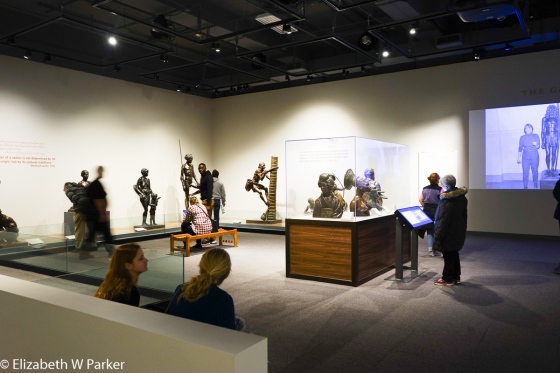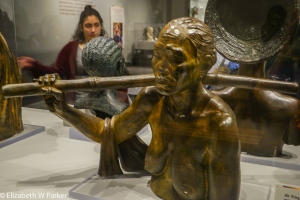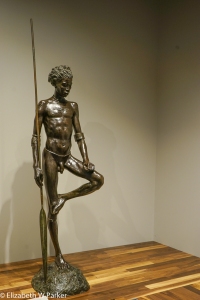I was in Chicago over the weekend for meetings, but carved out Saturday afternoon for an exhibit at The Field Museum of Natural History. My goal was to see an exhibit of bronzes by Malvina Hoffman, commissioned by the Museum in the early part of the last century and displayed until 1969.
Originally the bronzes were displayed in an exhibit with the name “The Races of Mankind.” They were to have been plaster, painted with the correct skin tones, but the artist prevailed upon the commissioners and said she could render the subtleties of her subjects in bronze and other materials.
The intent of the exhibition initially was to show that the Aryan race was superior to the other two (back then it was white, black and yellow) because whites were obviously less ‘savage’ and more cultured. Today that is laughable if not horrifying, but history shows that the view was fairly accepted in the years prior to World War II. It is said that the two men responsible for the exhibit and Hoffman’s commission, agreed with Hitler’s views on race.

Here you can see the display method – Like specimens in a natural history museum. I maintain that they should have been displayed like art.
Hoffman and her husband researched their subject exhaustively, using photographs and video that they themselves collected as well as materials from collection like those owned by the Field Museum. They traveled looking for models, and they also found many closer to home in the immigrants working in theme restaurants and clubs, for example.
The resulting bronzes are spectacular works of art, realistic in their details to the extent that the models can be identified by name in many cases. But as Hoffman worked, her doubts about the racial superiority arguments behind her commission only grew stronger. I could not discern any difference in the sculptures of her appreciation for any of her subjects or models.
The Races of Mankind exhibit did not survive the post-war period and the civil rights era. Science put into doubt the whole idea of genetically determined race, and certainly the superiority of any people based on skin color was no longer the majority thinking. The exhibit was dismantled and the bronzes consigned to oblivion in the Museum’s vaults or displayed individually as art in other sections of the Museum. Eventually, most were removed from display and left to gather dust, in the proverbial bowels of the building.
And now they have been given a new life. I fear it may be short-lived. As beautiful as these bronzes are, the exhibit is poorly curated in my opinion. The premise for showing them is weakly developed, and the fact that finding them at all was an adventure does not speak to an organizational conviction that they should be on display.
First, the title I found for the exhibit is one thing on the Museum’s website, and another thing by its signage. Second, when I asked about it when buying my ticket, the ticket seller had no idea what I was talking about nor where it was in the Museum. Third, where is it? It’s tucked away in a gallery (the Comer Gallery) behind the winding dark displays of the Pacific Spirits.
I am a firm believer that if you want to say something with an exhibit, say it firmly and clearly from the get go and with every piece you show explain the role it plays in what you are trying to say. This exhibit does not do that. It has way too many themes, all worthwhile ones, but none developed to the point that you could say “this is an exhibit about X.” (Perhaps that is why this review is so long!)The themes touched upon are the artistic value of the pieces (Hoffman and Rodin shared the same foundry for their works in Paris), conservation of works of art (how the bronzes were restored), the history of the original exhibit, the history of the concepts of race and racism, racism, human variety, the stories of the people behind the sculptures. But you cannot say this exhibit is about one of these predominantly.
It is a shame, really. It does not portend a future for the bronzes. Maybe the issue is that they do not belong in this museum at all – maybe they belong in an art museum (most museums are loathe to part with even the most insignificant of their artifacts, so I cannot see that happening.) What I could see is a strong exhibit on the history of racism and science that debunks it. The bronzes could be curated in such a way as to show how they were used to prove the racist theories for which they were commissioned, and the proof we have today, both scientifically and culturally that those theories were never based in science or reality.
Left on their own, the bronzes are a stunning statement to the incredible and beautiful variety of humankind. On their own, they are awe-inspiring works of art. With no explanation of anything, you would want to know who is this person? What was her life like? Where did he live and when? I do object to the displaying of the bronzes (most are just heads or busts) in lighted glass cases. That is pretty typical for artifacts throughout the museum, but sculpture almost demands that you be able to walk around it. And it makes it hard to really see the details with the glare off the glass from the lighting. Yes, the urge to touch sculpture is also overwhelming – but that is why museum’s establish boundaries and hire guards.
The exhibit makes ample use of technology. There are several monitors in the exhibit which allow you to read, see additional images and even video related to the bronzes. My guess is that these supplant the additional information people of my age are used to finding printed near an object. Unfortunately, one person who wants to see all the material needs to spend time in front of the display, preventing others from doing so. There is also a video showing on a high wall in the gallery that suffers from repeated images, though the narrative is informative.
Despite my negative review of the exhibit, I urge you to go see it. Artistically, it is a feast. The bronzes are beautiful. If you do read the material presented, you will have lots to mentally chew on, too. The issue of racism is not gone. Despite the science now available to us and political correctness required to deny it, the question of race and our beliefs about it still merit thought and discussion.
Looking at Ourselves: Rethinking the Sculptures of Malvina Hoffman
The Comer Gallery, The Field Museum of Natural History, Chicago, Illinois





You must be logged in to post a comment.